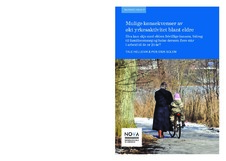| dc.description.abstract | Concern for the sustainability of the pension system and the future supply of workers has put increased labor force participation among the elderly high on the political agenda. Possible side effects of such a development for other areas have been explored only to a limited extent. In this report, we discuss what may happen to the contribution from the elderly to voluntary work and family care, and to their health, if fifty percent of the cohorts continue to work until they reach the age of 70. An important question is for example whether paid work might come to crowd out voluntary work. The report is based on descriptive analyses comparing working indivi-duals and pensioners in the age range 62-69, in relation to voluntary work, caring for a partner or parents, looking after grandchildren, and health status. We use the NorLAG study, a national representative survey conducted in 2007-2008. Despite being 10 years old, it is still the most suitable dataset due to its scope and the topics covered. With today’s situation as the starting point, we consider a hypothetical situation where close to three times as many individuals remain in paid work until they turn 70, and the consequences this may have for the participation in voluntary work and family care, and health status, among people in their sixties. The outcome of this hypothetical situation we reflect on is not a given, and the conclusions are open for discussion and alternative interpretations. The results from the NorLAG analyses show that relatively few indivi-duals in their sixties participate extensively in voluntary organizational work today. There is close to no difference between pensioners and those that are still in the labor force in this regard. Helping individuals outside of the closest family is also something few individuals in their sixties do with any frequency. Here we find a small tendency for pensioners to give assistance more often than workers do, particularly among individuals in the last half of their sixties. Both when comparing workers and pensioners at any given time, and when looking at individual changes over time, the conclusion is that grand-parents’ work activity does not appear to be a hindrance when it comes to look-ing after grandchildren. Since in most of the cases, the childcare takes place either weekly or monthly, it is, not surprisingly, possible to combine such activity with a job. In fact, looking after grandchildren is more common among working sixty-year-olds than among those that are not working, alleviating any fears that prolonging working lives would reduce the amount of care by grand-parents for their grandchildren. Increasing the labor force participation among individuals in their sixties does not appear to mean a higher risk of society losing an important source of care between partners or from grown children to elderly parents. Few indivi-duals in their sixties provide such care today. Furthermore, there is little to suggest that work activity has any strong impact on the tendency to contribute. Individuals that are still in paid work in their sixties have better perceived (subjective) health than pensioners do. Mental health varies considerably less with work status, but there is a slightly higher prevalence of depressive symp-toms among pensioners than among workers. This health difference is mainly the result of individuals in poor health in general leaving the workforce earlier than individuals in good health do. The effects in itself of retiring versus continuing to work are more complex, but there seems to be a slightly larger number of people benefitting from leaving early compared to the number of people benefitting from leaving late. However, the largest group of individuals appears to be those that experience no significant changes in their health whether they continue working or retire within the five-year period covered by the NorLAG data. All in all our analyses indicate that it is possible to prolong labor force participation until the age of 70 for up to 50 percent of the cohorts and at the same time maintain the age group’s contribution to voluntary work and family care. It is more unclear whether increased work force participation is compatible with an increase in voluntary work and family care from the elderly. Then again, potential increases do not have to happen in all areas for all individuals; while some may remain in the labor force for longer, others may do more voluntary work or take on more care responsibilities in the family. It is harder to predict the effects of an increase in work activity for the general health status among individuals in their sixties, as health clearly varies with work status while at the same time many different factors determine the consequences of retirement on health. | en |
